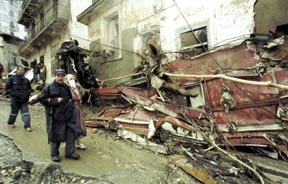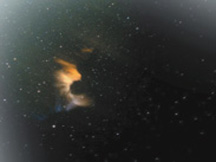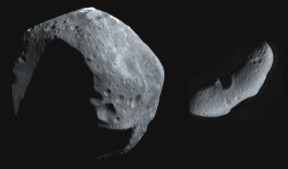Geotimes

Geophenomena
Flood
and mudslides in Algeria Leonid
magic Survey
predicts somewhat safer skies
Flood
and mudslides in Algeria
Between Friday morning on Nov.
9 and noon the following Saturday, 220 millimeters of rain inundated the capital
of Algeria, creating mudslides that left more than 750 people dead. The torrential,
36-hour downpour flooded 11 small rivers, called oueds in Arabic, which cross
the city of Algiers and lead to the neighborhood of Bab El Oued, or in English,
“The Door of the River.”
 “I believe
it is not the size of the flood or rainfall that produced the disaster, but
the weakness of the construction and the bad state of the sewage system,” says
civil engineer Djillali Benouar, who teaches at the University of Algiers and
is a member of the Alliance for Disaster Reduction. “The city center is located
at the foot of a 306-meter high hill,” he says. “The water washed away everything
it met on its way down to the sea, passing through the streets of the capital
and taking with it cars, buses, people, mud, rocks and houses.”
“I believe
it is not the size of the flood or rainfall that produced the disaster, but
the weakness of the construction and the bad state of the sewage system,” says
civil engineer Djillali Benouar, who teaches at the University of Algiers and
is a member of the Alliance for Disaster Reduction. “The city center is located
at the foot of a 306-meter high hill,” he says. “The water washed away everything
it met on its way down to the sea, passing through the streets of the capital
and taking with it cars, buses, people, mud, rocks and houses.”
[Residents
walk through a devastated street in Algiers after torrential rains lashed the
Algerian capital in November, sending water through its streets and mud down
its hilly terrain. A 24-hour deluge pounded northern Algeria, killing at least
287 people and injuring hundreds more. AP
Photo/Nabil]
The houses built on the flanks of the hill had shallow foundations, if any,
and were without water evacuation routes, Benouar says. “These were weak structures
vulnerable to heavy rain. Across the country, these kind of housing constructions
have suffered much damage from rain because of degradation, inadequate repair,
aging and neglect.”
The disaster in Algiers forced thousands of families to flee their homes. In
some parts of the city mud rose 13 feet. Morocco and France responded immediately
with rescue workers. France provided supplies such as tents, beds, blankets
and water purification equipment. Tunisia also responded with medicine, blankets
and food.
But local newspapers report outrage from residents over what they consider a
lax response from Algeria’s government, even though the government said it would
offer housing and financial assistance to those hardest hit.
“The floods laid bare the absence of political courage,” wrote the newspaper
Le Matin, adding that “the men leading us don’t even know how to react to a
weather bulletin.” From the capital, the Associated Press reported that armed
soldiers had dispersed a spontaneous demonstration of several hundred people
complaining about Algeria’s inadequate response to the crises and their own
poor living conditions.
The heavy rainfall broke a drought that had forced residents to ration water
since mid-October. Rainfall was expected to continue throughout late November,
feeding the small oueds, which are typically dry in the summer and flooded in
winter.
Christina Reed
Leonid
magic
 Every
33 years, the comet Tempel-Tuttle races around the sun, shedding a dusty cloud
of debris in its wake. And every year, as Earth spins its way through the remnant
material, stargazers hope to see blazing fireballs streak across the night sky
roaring, it seems, from the constellation of Leo the lion. On Nov. 18, with
a Cheshire-cat smile of a moon and clear skies in much of North America, the
Leonid meteor shower put on a full-fledged storm with more than 1,000 shooting
stars an hour.
Every
33 years, the comet Tempel-Tuttle races around the sun, shedding a dusty cloud
of debris in its wake. And every year, as Earth spins its way through the remnant
material, stargazers hope to see blazing fireballs streak across the night sky
roaring, it seems, from the constellation of Leo the lion. On Nov. 18, with
a Cheshire-cat smile of a moon and clear skies in much of North America, the
Leonid meteor shower put on a full-fledged storm with more than 1,000 shooting
stars an hour.
[At right, the Leonid that created this
smokey debris was very large and bright, illuminating the ground like lightning.
The debris train was about 1 minute old when the exposure was started. Courtesy
of Jim Bryan of Gaston, Ind.]
In one night, Earth crossed four different dust trails from the comet’s previous
trips. In North America, the first witnesses of the storm caught a spectacular
sight of falling stars from a trail the comet left during a trip around the
sun in 1766. Those in Hawaii watched meteoroids leftover from the year 1799
turn to meteors in the sky. A midnight gathering of 150 people in China on the
roof of a 550-year-old Ming Dynasty stone observatory saw early morning meteors
on Nov. 19, made from an 1866 cloud, that outshone the city lights of Beijing.
Those in Sydney, Australia, reported disappointment as rain clouds blocked the
view of shooting stars from dust left in space in 1699. But in other parts of
Australia and Indonesia, the storm jumped to nearly 3,000 meteors per hour,
according to Spaceweather.com.
Christina Reed
Survey
predicts somewhat safer skies
 A
team of Princeton University astronomers has lowered Earth’s estimated risk
of suffering a catastrophic impact from an asteroid. They have reduced the odds
to about one in 5,000 over the next century.
A
team of Princeton University astronomers has lowered Earth’s estimated risk
of suffering a catastrophic impact from an asteroid. They have reduced the odds
to about one in 5,000 over the next century.
Using data from the Sloan Digital Sky Survey (SDSS), the Princeton team, headed
by Zeljko Ivezic, estimated that the solar system contains about 700,000 asteroids
large enough to destroy a civilization. Previous estimates put the number at
about 2 million, suggesting a 1 in 1,500 chance of impact. These large asteroids
have a minimum diameter of 1 kilometer.
[Above, asteroids Mathilde (left) and
Eros are shown at the same scale, as they were imaged by NEAR Shoemaker from
about 1,800 kilometers on June 27, 1997, and Feb. 12, 2000, respectively. Mathilde
is 56 kilometers across, and Eros is 33 kilometers long and 13 kilometers wide.
Scientists have now lowered the estimate of impact risk from large asteroids.
Courtsey of NASA Jet Propulsion Laboratory.]
The Princeton team’s estimate draws on observations of 10,000 asteroids, particularly
faint ones — many more than past studies utilized. More importantly, Ivezic
says, the SDSS five-color band imaging allowed them to gauge the size of the
asteroids five times better than surveys using single-band data. Astronomers
can identify asteroid type and size based on the color and amount of light they
reflect.
The new impact risk, like those from most prior studies, relies on assumptions
about a single impact event 65 million years ago when a 10-kilometer asteroid
collided with Earth and created the Chicxulub crater. The researchers assume
that such impacts occur on roughly 100 million-year intervals, using that statistic
to calculate the impact odds for the more common, smaller asteroids.
Even with an accuracy margin of error of roughly a “factor of two,” the new
estimates are lower than previous ones, Ivezic says, with the odds ranging from
1 in 2,500 to 1 in 10,000. “The main problem with the impact hazard estimate
is its statistical nature: there is no guarantee that an impact won’t happen
on a much shorter, or much longer, time scale,” Ivezic says. “In order to protect
ourselves from a possible impact, we need to know precisely the trajectory of
that particular object that is on the collision course.”
Ivezic’s team published their work in the November Astronomical Journal. SDSS
is a multi-institutional collaboration that is mapping one-quarter of the sky.
Ivezic says their asteroid database will soon be available to the public on
the SDSS Web site: www.sdss.org.
Lisa M. Pinsker
 “I believe
it is not the size of the flood or rainfall that produced the disaster, but
the weakness of the construction and the bad state of the sewage system,” says
civil engineer Djillali Benouar, who teaches at the University of Algiers and
is a member of the Alliance for Disaster Reduction. “The city center is located
at the foot of a 306-meter high hill,” he says. “The water washed away everything
it met on its way down to the sea, passing through the streets of the capital
and taking with it cars, buses, people, mud, rocks and houses.”
“I believe
it is not the size of the flood or rainfall that produced the disaster, but
the weakness of the construction and the bad state of the sewage system,” says
civil engineer Djillali Benouar, who teaches at the University of Algiers and
is a member of the Alliance for Disaster Reduction. “The city center is located
at the foot of a 306-meter high hill,” he says. “The water washed away everything
it met on its way down to the sea, passing through the streets of the capital
and taking with it cars, buses, people, mud, rocks and houses.” 
 Every
33 years, the comet Tempel-Tuttle races around the sun, shedding a dusty cloud
of debris in its wake. And every year, as Earth spins its way through the remnant
material, stargazers hope to see blazing fireballs streak across the night sky
roaring, it seems, from the constellation of Leo the lion. On Nov. 18, with
a Cheshire-cat smile of a moon and clear skies in much of North America, the
Leonid meteor shower put on a full-fledged storm with more than 1,000 shooting
stars an hour.
Every
33 years, the comet Tempel-Tuttle races around the sun, shedding a dusty cloud
of debris in its wake. And every year, as Earth spins its way through the remnant
material, stargazers hope to see blazing fireballs streak across the night sky
roaring, it seems, from the constellation of Leo the lion. On Nov. 18, with
a Cheshire-cat smile of a moon and clear skies in much of North America, the
Leonid meteor shower put on a full-fledged storm with more than 1,000 shooting
stars an hour.  A
team of Princeton University astronomers has lowered Earth’s estimated risk
of suffering a catastrophic impact from an asteroid. They have reduced the odds
to about one in 5,000 over the next century.
A
team of Princeton University astronomers has lowered Earth’s estimated risk
of suffering a catastrophic impact from an asteroid. They have reduced the odds
to about one in 5,000 over the next century. 